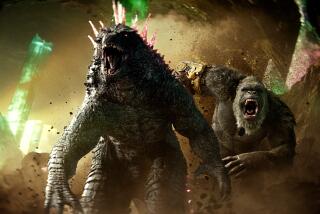Review: In ‘Pacific Rim,’ Del Toro makes magic with monsters
Guillermo del Toro is more than a filmmaker, he’s a fantasy visionary with an outsized imagination and a fanatical specificity, a creator of out-of-this world universes carefully conceived down to the smallest detail. His particular gifts and passions are on display in the long-awaited “Pacific Rim” and the results are spectacular.
This futuristic man versus monster tale is long-awaited because it has been five years since Del Toro’s last film, seven since his masterpiece, “Pan’s Labyrinth.” Two major projects, his version of “The Hobbit” and “At the Mountains of Madness,” fell apart despite extensive work, and “Pacific Rim” shows us what we’ve been missing.
Unless you are a fan of the “Godzilla”-influenced branch of Japanese popular cinema that inspired Del Toro and his co-writer Travis Beacham, “Pacific Rim’s” plot of ferocious creatures called Kaiju facing off against massive robots called Jaegers may not, frankly, sound all that appealing.
PHOTOS: Robots, kaiju and battles from ‘Pacific Rim’
But filmgoers have learned that underestimating Del Toro and what he can do on screen is something done at your peril. He’s so accomplished a creator of images, so adept at humanizing the monstrous, so fearless an architect of awe, that even without major movie stars in the cast, the scenarios he throws himself into are invariably difficult to resist.
Beginning in the near future, “Pacific Rim’s” entertainingly complex back story starts with the outlandish notion that we’ve been looking in the wrong direction when we’ve worried about aliens invading Earth from another planet.
Rather, a fissure between two tectonic plates in the Pacific opens a portal between dimensions, and the Kaiju, strange and awful giant beasts intent on destroying everything in their path, come up from the depths and begin laying waste to coastal cities like San Francisco.
Humanity cooperates across national borders in the face of this terrifying threat and creates truly huge Jaegers, weaponized robots so large (250 feet high) that it takes two people to pilot them. Not just any two, however, make effective collaborators.
For a team to succeed, something called “The Drift,” a psychological state of oneness that sounds suspiciously like “Star Trek’s” venerable Vulcan mind meld, must exist between the participants. When Jaeger teams initially meet with success, these pilot pairings from around the globe become as popular as international rock stars.
VIDEO: Guillermo del Toro on Japanese pop culture influence
The year is now 2020 and when ace Jaeger pilots Raleigh Becket (Charlie Hunnam of TV’s “Sons of Anarchy”) and his brother Yancey (“Homeland’s” Diego Klattenhoff) respond to a Kaiju attack just outside of Anchorage they get more than they expected. While earthlings were celebrating and getting cocky, the Kaiju were biding their time, changing, evolving and adapting.
Cut to five years later. Raleigh is now a drifter, living off the grid as he copes with the aftermath of that day in Anchorage. Meanwhile, the Kaiju have gotten so smart that the world community is about to abandon the Jaeger program and put its faith in a clearly dubious sea wall instead.
The ultra-fierce Stacker Pentecost (Idris Elba, “The Wire’s” Stringer Bell), a former military man, thinks he has a better idea. But he has only a few months to pull together a team of veteran pilots, hole up in the Shatterdome facility in Hong Kong and facilitate his against-all-odds plan to bring the Kaiju to their knees. A plan that includes Stacker’s enigmatic protégé Mako Mori (“Babel’s” Rinko Kikuchi), a young Japanese woman with secrets of her own.
Clearly we’re not talking about “The Remembrance of Things Past” here. “Pacific Rim” very much lives in comic book/pulp science-fiction territory, complete with comic relief scientists (Charlie Day and Burn Gorman). But a number of factors combine to make it a deeper movie experience.
For one thing, this futuristic world has been carefully thought out and physically created with great skill. The visually gifted Del Toro has worked with his own team and the experts at Industrial Light & Magic to ensure that the monsters and the havoc they wreak look real. And the film’s delicate conversion to 3-D is a model of how to use the third dimension with maximum effectiveness.
Concerned with more than the big picture, however, “Pacific Rim’s” creators have fussed with thousands of small details to make the gritty, dirty world of Shatterdome and surrounding Hong Kong (which owe an honorable debt to “Blade Runner’s” landmark look) as lived-in as possible.
Unlike what can happen in other futuristic epics, the flesh-and-blood people who inhabit this world have not been neglected. Expertly cast by Margery Simkin, “Pacific Rim” utilizes many actors who have followings on TV, including Del Toro veteran Ron Perlman, which allows the film to capitalize on the work of talented people who have not worn out their welcome on the big screen.
And though Del Toro could have used motion capture to depict the crucial scenes of the pilot teams actually operating the Jaegers, he chose to do it in a much more old-fashioned and demanding way that emphasizes the physicality of the actors’ exertions. That in turn makes the situation more credible and enhances the crucial character/audience connection.
Those who stay to the end of “Pacific Rim’s” credits will experience a particularly poignant moment. The last card standing is in memory of “Monster Masters” Ray Harryhausen, the king of stop-motion animation, and Ishiro Honda, the director of “Godzilla.” In a field rife with impostors and poseurs, Del Toro, like his mentors, is the real deal. It’s good to have him working his magic again.
---------------------------------
‘Pacific Rim’
MPAA rating: PG-13 for sequences of intense sci-fi action and violence throughout, and brief language
Running time: 2 hours, 11 minutes
Playing: In general release
More to Read
Only good movies
Get the Indie Focus newsletter, Mark Olsen's weekly guide to the world of cinema.
You may occasionally receive promotional content from the Los Angeles Times.







